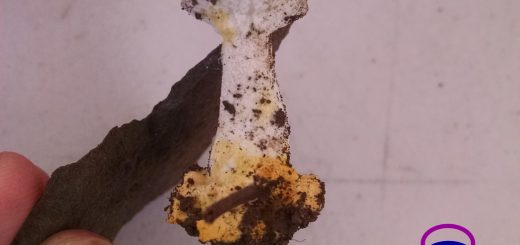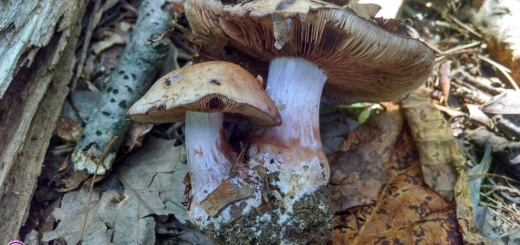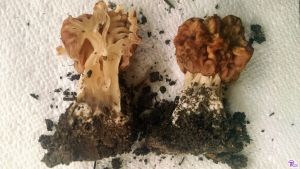#071: Flammulina velutipes, The Velvet Foot [Archived]
Note: This is an archived post. The current version of this post is available here.
This edible mushroom can be found in specialty markets under the names “Enokitake” and “” It can also be found in the wild in temperate areas across the Northern Hemisphere, but the wild mushrooms look nothing like the cultivated versions. Flammulina velutipes has many common names, including: Velvet Foot, Enokitake, Enoki, Winter Mushroom, Velvet Stem, Velvet Shank, Golden Needle Mushroom, and others. I am using the name Velvet Foot because it is among the most commonly used names and it sounds the most poetic. According to Wikipedia, Enoki is the Japanese name for the Chinese Hackberry Tree, a tree in the hemp family on which F. velutipes is often found. Thus, “Enokitake” means “Chinese Hackberry Tree Mushroom.” Wikipedia also says that the Chinese names for this mushroom translate to Golden Needle Mushroom or Golden Mushroom. How can one mushroom have such a wide variety of common names? In this case, it is because the wild and cultivated mushrooms take morphologically distinct forms.
In the wild, F. velutipes can be found decomposing hardwood logs starting in fall and continuing throughout the winter (thus the common name The Winter Mushroom). It particularly likes warm spells in the winter and cold snaps during other seasons. Although normally found on wood above ground, the Velvet Foot sometimes decomposes subterranean wood and may therefore appear to be growing terrestrially. This medium-sized mushroom features a 1-7cm wide, convex to flat cap that varies in color from yellowish brown to dark orange. The cap is smooth and is moist or sticky when fresh. Underneath the cap, the Velvet Foot sports whitish to yellowish gills that are attached to the central stipe. These gills form close together and usually dip slightly before they connect to the stipe. If you let the gills drop their spores onto a piece of paper, you will end up with a white spore print. The common name Velvet Foot comes from the bottom of the stipe, which is dark brown to black and is minutely fuzzy. Tiny, white hairs coat the entire surface of the stipe, giving it a velvety appearance, like that of the surface of a peach. The stipe starts out the same color as the cap, but gradually darkens from the base up.
Cultivated forms of F. velutipes, on the other hand, have a tiny, white cap at the end of a long, thin, white stipe. This drastic difference in morphology can be explained by the fact that Enokitake is grown in complete darkness. In order to ensure that its spores are dropped into the air rather than under the ground, the mushrooms grow long and thin until they find a light source. This conserves energy and increases the mushroom’s chances of successfully reproducing. There is a great picture on Tom Volk’s F. velutipes page (linked below) showing the Velvet Foot growing from a stump with patches of bark on it. Underneath the bark (removed for the picture), the mushrooms are long, thin, and white. Once the mushrooms find the light at the edge of the bark, they begin growing as you normally find them in the wild. Enokitake is grown in jars and fruits out of the top of the open jar, kind of like the mushroom version of a Chia Pet. The mushrooms are removed from the jar, packaged fresh or canned, and sold in stores. If you buy fresh enokitake, you must cut off the inedible mass at the base before the mushrooms can be used. Enokitake is usually used as a garnish for salads and soups. It becomes tough when cooked, so you need to add it at the last minute when cooking.
F. velutipes also has the distinction of having been grown in space. In 1993, the mushrooms were sent up aboard the space shuttle Columbia. As a result of the low gravity, they ended up growing in all different directions rather than orienting their caps in the same direction. This was a predictable result, but now we know that gravity is important in mushroom formation rather than just assuming that gravity is important. Of course, there are other mushrooms that have flown in space. My favorite ones were found growing next to the space toilet on the International Space Station in 2008.
There are a couple of F. velutipes look-alikes that can be found in the wild. The most important of these is Galerina marginata (FFF#124), which is DEADLY POISONOUS. G. marginata contains amatoxins, which are the same poisons found in the Destroying Angels and the Death Cap (see FFF#091). Most G. marginata poisonings occur when people mistake the mushroom for F. velutipes. The two fungi both decompose hardwood logs and are sometimes found fruiting side by side. To avoid accidently ingesting G. marginata, YOU MUST CHECK EACH MUSHROOM YOU COLLECT FOR SPORE PRINT COLOR AND THE PRESENCE OF A RING. G. marginata has a small ring around its stipe near the top, while the Velvet Foot does not form a ring. Sometimes the ring falls off, so you must also take the spore print for every ringless mushroom. G. marginata has a brown spore print, while F. velutipes has a white spore print. A much less dangerous look-alike is Flammulina populicola, which is closely related to the Velvet Foot. F. populicola is visually indistinguishable from F. velutipes. However, F. populicola is only found on poplars (including Quaking Aspen and Narrowleaf Cottonwood) in Western North America. The Velvet Foot, on the other hand, is never found on poplars in Western North America, making identification a “simple” matter of identifying the host tree. If, like me, your tree identification skills need some work, the two species can also be separated out based on microscopic characteristics.
See Further:
http://www.mushroomexpert.com/flammulina_velutipes.html (read this to learn more about how F. velutipes expanded its range across three continents)
http://botit.botany.wisc.edu/toms_fungi/march97.html
http://www.mykoweb.com/CAF/species/Flammulina_velutipes.html









![#011: Characteristics of Kingdom Fungi [Archived]](https://www.fungusfactfriday.com/wp-content/themes/hueman/assets/front/img/thumb-small-empty.png)


2 Responses
[…] velutipes (FFF#071) also fruits in dense clusters in the fall and winter. Typically, that mushroom produces lots of […]
[…] This phenomenon is immediately apparent when you look at a mushroom. Consider Flammulina velutipes (FFF#071): the cap is orange and slimy, while the stipe is blackish and tough. All these physical […]